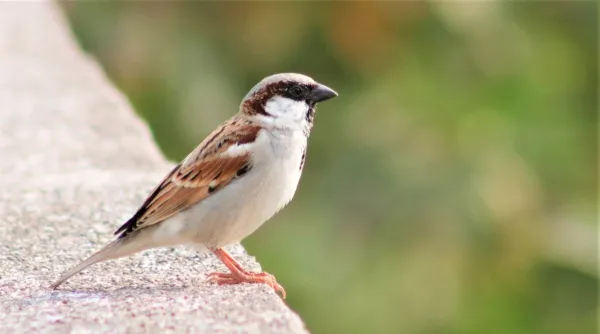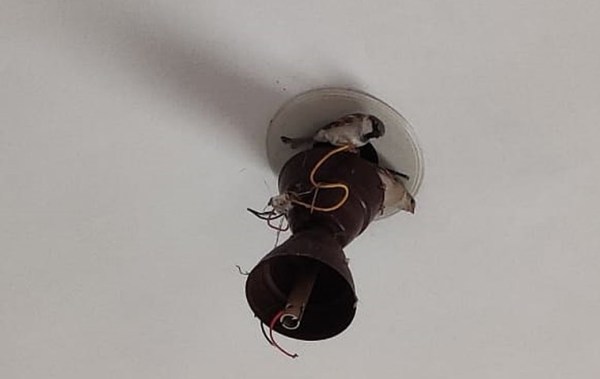Many common species of birds share our surroundings. But for many of us, the first bird we were introduced to would be the familiar, lovely and tiny house sparrow.
You all have to agree with me that the sparrow is the very first bird of our childhood. We all were so eager to see this bird – called various names like house sparrow, ghar chakli, goraiya, chatka etc. – in our childhood. We all start our first birding through the sparrow. Many times, the call ‘chi…chi’ of a sparrow has persuaded us to stop crying. The chirping brings a smile to children’s faces.

 A male house sparrow. (Credit: Anurag Sagar)The main character of many childhood stories, the sparrow is a symbol of instant happiness. When sparrows enter our home or balcony, it is a pleasant moment for us. The sparrow is the most common and well-known bird in our backyard.
A male house sparrow. (Credit: Anurag Sagar)The main character of many childhood stories, the sparrow is a symbol of instant happiness. When sparrows enter our home or balcony, it is a pleasant moment for us. The sparrow is the most common and well-known bird in our backyard.
Since time immemorial, the sparrow has loved to live in human habitats and avoids staying in thick and lonely forests. Sparrows travel with humans, even accompanying farmers to their farms and fields where they feed on crops and insects and breed. The name ‘house sparrow’ is given to this bird because of this special quality. It never minds the presence of humans and is a very social bird. It is found all over India and the world.
Also read | Birds without Borders: Indian grey hornbill, the conjugal love birds that love Gujarat cities
Delhi and Bihar have even given the house sparrow the honour of being the state bird.
The house sparrow (scientific name passer domesticus) is a small passerine bird around 16 cm long and weighs 24–39.5 gm. The male and female birds look different in colour and size. The male is bigger than the female and has a dark brown colouration with a grey crown. Males have brighter black, white, and brown markings and whitish underparts. The male’s bill is dark grey but black in the breeding season. He has a remarkable black patch on his throat. The female is pale brown in colour with light supercilium with greyish-white underparts.
The sparrow has a diverse diet and eats all types of millets, especially small grains like bajra (pearl millet), broken rice, kang (foxtail millet), seeds of grass, invertebrate insects, worms etc.
Advertisement
Sparrows love bathing. They bathe in dust or water, often in groups. Dust baths help them remove extra oil from their feathers. Bathing in water helps them cool down their bodies in the summer. Birds rub insects on their bodies to get relief from parasites. This behaviour is known as anting.
 A house sparrow couple inside a ceiling fan cup. (Credits: Sushila Rathod)We must know that the nest is not the house or shelter of birds because they never live in nests; they roost on trees. Most communal chirping occurs before and after the birds settle for roosting in the evening as well as before the birds leave the roost in the morning. We can say the nest is the maternity home or training centre for the chicks.
A house sparrow couple inside a ceiling fan cup. (Credits: Sushila Rathod)We must know that the nest is not the house or shelter of birds because they never live in nests; they roost on trees. Most communal chirping occurs before and after the birds settle for roosting in the evening as well as before the birds leave the roost in the morning. We can say the nest is the maternity home or training centre for the chicks.
Nests of sparrows are not artistic like those of the weaver or tailor bird. They use dry grass, soft feathers, cotton, and tiny fibres to make a simple nest. Generally, they use small cavities to make nests. House sparrows live with humans and often make nests in our houses. In Gujarat, houses used to have special corners or cavities called gokhalo in Gujarati in their walls for sparrows to build nests. Photo frames used to be the most common and favourite place for sparrows to construct their nests.
Also read | Birds Without Borders: Purple sunbird, a shiny-black home visitor
However, modern urban architecture and interior design no longer support photo frames. We don’t keep our doors and windows open for a long time and this way, we restrict the entry of sparrows to our house. AC culture also restricts sparrows’ entry. Glass structures and mall culture are also a threat to these tiny birds. The packed food and grocery items sold by malls have broken the food chain in a sense. In the past, sparrows were directly getting food from open provision stores.
In the face of such adversity, sparrows have shown some resilience and adaptation skills. They have started using man-made cardboard and earthen nests for laying eggs and raising their young ones.

Concerned about the declining population of house sparrows, Mohammed Dilawar, a Nashik-based naturalist founded the Nature Forever Society in 2005 and launched a campaign to arrest the dwindling number of these birds. He came forward and started the ‘Save the Sparrows’ movement. As a result of his hard work, we got a special day for awareness regarding the declining population of sparrows. Since 2009, we have been observing World Sparrow Day on March 20 every year.
The conservation status of this tiny but important bird species has been assessed to be of least concern on the Red List of The International Union for Conservation of Nature (IUCN) with a remark that its population is showing a declining trend.
Also read | Birds Without Borders | Baya weavers, the birds that attract mates with their nesting skills

We can bring back or invite sparrows by providing man-made nests at suitable and safe places, by keeping bird feeders with small grains, and earthen water pots and tubs for these birds to drink water and bathe.
The sparrow is also a symbol of prosperity. In the late 1950s and early 1960s, China culled sparrows on a large scale after deeming them a pest and even organised sparrow hunting competitions. It was believed that sparrows destroyed crops and negatively affected the economy. However, there was a big attack by locusts on the green fields. The population of predators like sparrows that kill locusts had declined drastically and therefore, the insects destroyed crops, leading to a famine in China for years. China eventually realised its mistake and took steps to increase its sparrow population, to save their food and the economy. This is the real story of our tiny sparrow. How helpful this tiny creature is!
There is also a sparrow memorial near Dhal ni Pol in Astodia in the walled city of Ahmedabad, India’s first UNESCO World Heritage city. A sparrow died in police firing during the Navnirman movement and people made a plaque in its memory.
(Sushila Rathod is a technical assistant with the School of Energy Technology of Pandit Deendayal Energy University, Gandhinagar and a birdwatcher based in Gandhinagar.)





